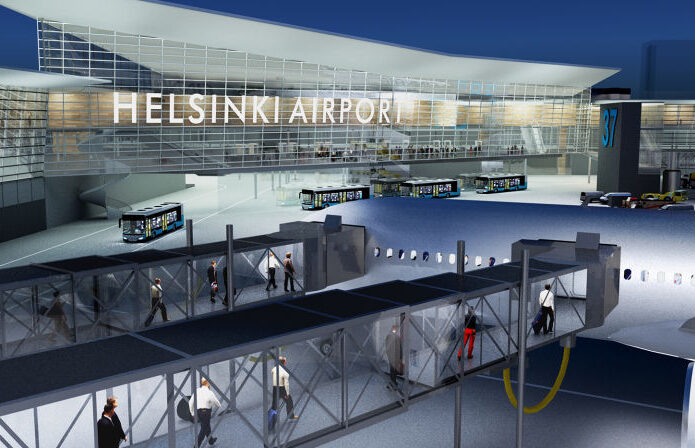Helsinki Airport: Better customer experience under one roof

It’s 20 by 2020—twenty million passengers a year by the beginning of the next decade. Helsinki Airport is carrying out a roaring EUR 900 million renovation, a complex overhaul of the airport’s infrastructure. “We are happy about the solution—increase the capacity of the existing compact infrastructure under one roof”, says Ville Haapasaari, Senior Vice-President of Finavia and Director of Helsinki Airport.
The leap to the 20-millionth traveller, should, however, not mean any compromise on what’s dear to every Finnish heart and greatly appreciated by foreign visitors—its welcoming atmosphere, cosy homeliness and woollen comfort.
What makes Helsinki so special?
“It’s the size and passenger comfort”, says Mr Haapasaari. “We do not compromise on the size. Helsinki is still a medium-sized airport compared to most other major European airports. We want to become bigger while keeping it small.”

“While revamping as much as possible and expanding the floor area, we are not adding new terminals. Helsinki will keep its relatively small size, where everything is close at hand and yet the space is not crowded. The size is also key to allow for shorter transfer times.”
Ville Haapasaari
Senior Vice-President at Finavia corp. and Director of Helsinki Airport.
Finavia maintains a network of 22 airports in Finland and the air navigation system which covers the country.
Photo: Finavia
One of the major hubs for flights between Europe with Asia, Helsinki is getting ready to progress into the second stage of its investment programme, designed “to ensure that Helsinki Airport maintains its strong competitive position”, says Mr Haapasaari.
Recent studies show that one third of travellers choose flights based on the transfer airport.
“If we are to succeed in competition, we need to improve all the time. We are investing so that Helsinki remains a major player in the toughening competition for transfer passengers, particularly in the growing intercontinental segment.”
“We also want to provide our airline customers the kinds of facilities and capacity where they can focus on growing their business”, Mr Haapasaari continues.
In 2015, Helsinki Airport serviced 16.4 million passengers, showing a 3% growth on the previous year. About 15% of all passengers flew to or from non-European destinations, primarily East Asia, Southeast Asia and the US.
From Helsinki, the turnaround time to even faraway Asian destinations is less than 24 hours. This is advantageous for airlines and convenient for passengers.
“We would like passengers as well as airlines to think of Helsinki when considering a destination in Asia. Helsinki has 85 flights to destinations in Asia every week, which is more than Stockholm, Oslo and Copenhagen put together”, says Mr Haapasaari.
For Helsinki Airport, the growth is coming from long-haul connections. The second stage of the Helsinki Airport refurbishing programme is concentrating on expanding the capacity for non-Schengen flights.
Once the new southern wing of the non-Schengen area is completed, development will progress to expand the western wing, to be launched in 2020. The floor area of the airport will grow by 45% to 330,000 square metres. Further plans include expanding Terminal 2 so that check-in, security control, and baggage drop all take place in one departure hall.
“The key to expanding the floor area and not compromising on the customer experience is the under-one-roof concept, which we are happy about—it allows us to increase the capacity of the existing compact infrastructure under the same roof”, Mr Haapasaari continues.
“The airport should be easy to handle for a passenger—distances should be kept short and services accessible.”
For interior design, the airport has chosen the ambience inspired by the Finnish landscapes. Helsinki is also investing in eight new wide-body aircraft jet bridges, new bus gates, an expansion of the baggage handling centre, renovation and expansion of the apron area, and other infrastructure improvements.
Expanding the facilities outside the terminal allows the airport to overhaul commercial services and public transport arrangements. In 2015, a railway link was launched between the airport and Helsinki city centre. The director of the airport is convinced that the development project, co-financed with a EUR 150 million loan from NIB, will have a positive impact on the development of the Finnish economy.
“Convenient flight connections mean a lot for creating an advantageous climate for doing business. Many Finnish and foreign businesses are benefitting from having a vibrant international airport in Helsinki”, Mr Haapasaari concludes.

